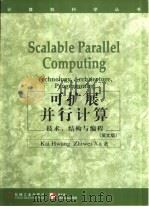《可扩展并行计算 技术、结构与编程 英文版》
| 作者 | (黄凯)KaiHwang,(徐志伟)ZhiweiXu著 编者 |
|---|---|
| 出版 | 北京:机械工业出版社 |
| 参考页数 | 802 |
| 出版时间 | 1999(求助前请核对) 目录预览 |
| ISBN号 | 711107176X — 求助条款 |
| PDF编号 | 88812008(仅供预览,未存储实际文件) |
| 求助格式 | 扫描PDF(若分多册发行,每次仅能受理1册) |

PartⅠScalability and Clustering1
Chapter 1 Scalable Computer Platforms and Models3
1.1 Evolution of Computer Architecture5
1.1.1 Computer Generations5
1.1.2 Scalable Computer Architectures6
1.1.3 Converging System Architectures8
1.2 Dimensions of Sealability9
1.2.1 Resource Scalability9
1.2.2 Application Scalability11
1.2.3 Technology Scalability12
1.3 Parallel Computer Models13
1.3.1 Semantic Attributes14
1.3.2 Performance Attributes17
1.3.3 Abstract Machine Models18
1.3.4 Physical Machine Models26
1.4 Basic Concepts of Clustering30
1.4.1 Cluster Characteristics30
1.4.2 Architectural Comparisons31
1.4.3 Benefits and Difficulties of Clusters32
1.5.1 Principle of Independence37
1.5 Scalable Design Principles37
1.5.2 Principle of Balanced Design39
1.5.3 Design for Scalability44
1.6 Bibliographic Notes and Problems47
Chapter 2 Basics of Parallel Programming51
2.1 Parallel Programming Overview51
2.1.1 Why Is Parallel Programming Difficult?52
2.1.2 Parallel Programming Environments55
2.1.3 Parallel Programming Approaches56
2.2.1 Definitions of an Abstract Process59
2.2 Processes, Tasks, and Threads59
2.2.2 Execution Mode62
2.2.3 Address Space63
2.2.4 Process Context65
2.2.5 Process Descriptor66
2.2.6 Process Control67
2.2.7 Variations of Process70
2.3 Parallelism Issues71
2.3.1 Homogeneity in Processes72
2.3.2 Static versus Dynamic Parallelism74
4.3 Microprocessor Architecture Families74
2.3.3 Process Grouping75
2.3.4 Allocation Issues76
2.4 Interaction/Communication Issues77
2.4.1 Interaction Operations77
2.4.2 Interaction Modes80
2.4.3 Interaction Patterns82
2.4.4 Cooperative versus Competitive Interactions84
2.5 Semantic Issues in Parallel Programs85
2.5.1 Program Termination85
2.5.2 Determinacy of Programs86
2.6 Bibliographic Notes and Problems87
3.1 System and Application Benchmarks91
Chapter 3 Performance Metrics and Benchmarks91
3.1.1 Micro Benchmarks92
3.1.2 Parallel Computing Benchmarks96
3.1.3 Business and TPC Benchmarks98
3.1.4 SPEC Benchmark Family100
3.2 Performance versus Cost102
3.2.1 Execution Time and Throughput103
3.2.2 Utilization and Cost-Effectiveness104
3.3 Basic Performance Metrics108
3.3.1 Workload and Speed Metrics108
3.3.2 Caveats in Sequential Performance111
3.4.1 Computational Characteristics113
3.4 Performance of Parallel Computers113
3.4.2 Parallelism and Interaction Overheads115
3.4.3 Overhead Quantification118
3.5 Performance of Parallel Programs126
3.5.1 Performance Metrics126
3.5.2 Available Parallelism in Benchmarks131
3.6.1 Amdahl s Law: Fixed Problem Size134
3.6.2 Gustafson s Law: Fixed Time136
3.6.3 Sun and Ni s Law: Memory Bounding139
3.6.4 Isoperformance Models144
3.7Bibliographic Notes and problems148
Part ⅡEnabling Technologies153
Chapter 4 Microprocessors as Building Blocks155
4.1 System Development Trends155
4.1.1 Advances in Hardware156
4.1.2 Advances in Software159
4.1.3 Advances in Applications160
4.2.1 Basics of Instruction Pipeline164
4.2 Principles of Processor Design164
4.2.2 From CISC to RISC and Beyond169
4.2.3 Architectural Enhancement Approaches172
4.3.1 Major Architecture Families174
4.3.2 Superscalar versus Superpipelined Processors175
4.3.3 Embedded Microprocessors180
4.4.1 Digital s Alpha 21164 Microprocessor182
4.4 Case Studies of Microprocessors182
4.4.2 Intel Pentium Pro Processor186
4.5 Post-RISC, Multimedia,and VLIW191
4.5.1 Post-RISC Processor Features191
4.5.2 Multimedia Extensions195
4.5.3 The VLIW Architecture199
4.6 The Future of Microprocessors201
4.6.1 Hardware Trends and Physical Limits201
4.6.3 Future Workloads and Challenges203
4.6.3 Future Microprocessor Architectures204
4.7 Bibliographic Notes and Problems206
5.1.1 Characteristics of Storage Devices211
5.1 Hierarchical Memory Technology211
Chapter 5 Distributed Memory and Latency Tolerance211
5.1.2 Memory Hierarchy Properties214
5.1.3 Memory Capacity Planning217
5.2 Cache Coherence Protocols220
5.2.1 Cache Coherency Problem220
5.2.2 Snoopy Coherency Protocols222
5.2.3 The MESI Snoopy Protocol224
5.3.1 Memory Event Ordering228
5.3 Shared-Memory Consistency228
5.3.2 Memory Consistency Models231
5.3.3 Relaxed Memory Models234
5.4 Distributed Cache/Memory Architecture237
5.4.1 NORMA, NUMA ,COMA, and DSM Models237
5.4.2 Directory-Based Coherency Protocol243
5.4.3 The Stanford Dash Multiprocessorr245
5.4.5 Directory-Based Protocol in Dash248
5.5 Latency Tolerance Techniques250
5.5.1 Latency Avoidance, Reduction ,and Hiding250
5.5.2 Distributed Coherent Caches253
5.5.3 Data Prefetching Strategies255
5.6 Multithreaded Latency Hiding257
5.5.4 Effects of Relaxed memory Consistency257
5.6.1 Multithreaded Processor Model258
5.6.2 Context-Switching Policies260
5.6.3 Combining latency Hiding Mechanisms265
5.7 Bibliographic Notes and Problems266
Chapter 6 System Interconnects and Gigabit Networks273
6.1 Basics of Interconnection Network273
6.1.1 Interconnection Environments273
6.1.2 Network Components276
6.1.3 Network Characteristics277
6.1.4 Network Performance Metrics280
6.2 Network Topologies and Properties281
6.2.1 Topological and Functional Properties281
6.2.2 Routing Schemes and Functions283
6.2.3 Networking Topologies286
6.3.1 Multiprocessor Buses294
6.3 Buses, Crossbar ,and Multistage Switches294
6.3.2 Crossbar Switches298
6.3.3 Multistage Interconnection Networks301
6.3.4 Comparison of Switched Interconnects305
6.4 Gigabit Network Technologies307
6.4.1 Fiber Channel and FDDI Rings307
6.4.2 Fast Ethernet and Gigabit Ethernet310
6.4.3 Myrinet for SAN/LAN Construction313
6.4.4 HiPPI and SuperHiPPI314
3.6 Scalability and Speedup Analysis314
6.5 ATM Switches and Networks318
6.5.1 ATM Technology318
6.5.2 ATM Network Interfaces320
6.5.3 Four Layers of ATM Architecture321
6.5.4 ATM Internetwork Connectivity324
6.6 Scalable Coherence Interface326
6.6.1 SCI Interconnects327
6.6.2 Implementation Issues329
6.6.3 SCI Coherence Protocol332
6.7 Comparison of Network Technologies334
6.7.1 Standard Networks and Perspectives334
6.7.2 Network Performance and Applications335
6.8 Bibliographic Notes and Problems337
Chapter 7 Threading, Synchronization ,and Communication343
7.1 Software Multithreading343
7.1.1 The Thread Concept344
7.1.2 Threads Management346
7.1.3 Thread Synchronization348
7.2 Synchronization Mechanisms349
7.2.1 Atomicity versus Mutual Exclusion349
7.2.2 High-Level Synchronization Constructs355
7.2.3 Low-Level Synchronization Primitives360
7.2.4 Fast Locking Mechanisms364
7.3 The TCP/IP Communication Protocol Suite366
7.3.1 Features of The TCP/IP Suite367
7.3.2 UDP, TCP, and IP371
7.3.3 The Sockets Interface375
7.4 Fast and Efficient Communication376
7.4.1 Key Problems in Communication377
7.4.2 The log P Communication Model384
7.4.3 Low-Level Communications Support386
7.4.4 Communication Algorithms396
7.5 Bibliographic Notes and Problems398
Part Ⅲ Systems Architecture403
Chapter 8 Symmetric and CC-NUMA Multiprocessors407
8.1 SMP and CC-NUMA Technology407
8.1.1 Multiprocessor Architecture407
8.1.2 Commercial SMP Servers412
8.1.3 The Intel SHV Server Board413
8.2 Sun UItra Enterprise 10000 System416
8.2.1 The Uitra E-10000 Architecture416
8.2.2 System Board Architecture418
8.2.3 Scalability and Availability Support418
8.2.4 Dynamic Domains and Performance420
8.3 HP/Convex Exemplar X-Class421
8.3.1 The Exemplar X System Architecture421
8.3.2 Exemplar Software Environment424
8.4 The Sequent NUMA-Q 2000425
8.4.1 The NUMA-Q 2000 Architecture426
8.4.2 Software Environment of NUMA-Q430
8.4.3 Performance of the NUMA-Q431
8.5 the SGI/Cray Origin 2000 Superserver434
8.5.1 Design Goals of Origin 2000 Series434
8.5.2 The Origin 2000 Architecture435
8.5.3 The Cellular IRIX Environment443
8.5.4 Performance of the Origin 2000447
8.6 Comparison of CC-NUMA Architectures447
8.7 Bibliographic Notes and Problems451
9.1.1 Classification of Clusters453
Chapter 9 Support of Clustering and Availability453
9.1 Challenges in Clustering453
9.1.2 Cluster Architectures456
9.1.3 Cluster Design Issues457
9.2 Availability Support for Clustering459
9.2.1 The Availability Concept460
9.2.2 Availability Techniques463
9.2.3 Checkpointing and Failure Recovery468
9.3 Support for Single System Image473
9.3.1 Single System Image Layers473
9.3.2 Single Entry and Single File Hierarchy475
9.3.3 Single I/O,Networking,and Memory Space479
9.4 Single System Image in Solaris MC482
9.4.1 Global File System482
9.4.2 Global Process Management484
9.4.3 Single I/O System Image485
9.5 Job Management in Clusters486
9.5.1 Job Management System486
9.5.2 Survey of Job Management Systems492
9.5.3 Load-Sharing Facility(LSF)494
9.6 Bibliographic Notes and Problems501
Chapter 10 Clusters of Servers and Workstations505
10.1 Cluster Products and Research Projects505
10.1.1 Supporting Trend of Cluster Products506
10.1.2 Cluster of SMP Servers508
10.1.3 Cluster Research Projects509
10.2 Microsoft Wolfpack for NT Clusters511
10.2.1 Microsoft Wolfpack Configurations512
10.2.2 Hot Standby Multiserver Clusters513
10.2.3 Active Availability Clusters514
10.2.4 Fault-Tolerant Multiserver Cluster516
10.3 The IBM SP System518
10.3.1 Design Goals and Strategies518
10.3.2 The SP2 System Architecture521
10.3.3 I/O and Internetworking523
10.3.4 The SP System Software526
10.3.5 The SP2 and Beyond530
10.4 The Digital TurCluster531
10.4.1 The TruCluster Architecture531
10.4.2 The Memory Channel Interconnect534
10.4.3 Programming the TruCluster537
10.4.4 The TruCluster System Software540
10.5 The Berkeley NOW Project541
10.5.1 Active Messages for Fast Communicatio541
10.5.2 GLUnix for Global Resource Management547
10.5.3 The xFS Serverless Network File System549
10.6 TreadMarks: A Software-Implemented DSM Cluster556
10.6.1 Boundary Conditions556
10.6.2 User Interface for DSM557
10.6.3 Implementation Issues559
10.7 Bibliographic Notes and Problems561
11.1.1 MPP Characteristics and Issues565
11.1 An Overview of MPP Technology565
Chapter 11 MPP Architecture and Performance565
11.1.2 MPP Systems-An Overview569
11.2 The Cray T3E System570
11.2.1 The System Architecture of T3E571
11.2.2 The System Software in T3E573
11.3 New Generation of ASCI/MPPs574
11.3.1 ASCI Scalable Design Strategy574
11.3.2 Hardware and Software Requirements576
11.3.3 Contracted ASCI/MPP Platforms577
11.4.1 The Option Red Architecture579
11.4 Intel/Sandia ASCI Option Red579
11.4.2 Option Red System Software582
11.5 Parallel NAS Benchmark Results584
11.5.1 The NAS Parallel Benchmarks585
11.5.2 Superstep Structure and Granularity586
11.5.3 Memory, I/O, and Communications587
11.6 MPI and STAP Benchmark Results590
11.6.1 MPI Performance Measurements590
11.6.2 MPI Latency and Aggregate Bandwidth592
11.6.3 STAP Benchmark Evaluation of MPPs594
11.6.4 MPP Architectural Implications600
11.7 Bibliographic Notes and Problems603
Part Ⅳ Parallel Programming607
Chapter 12 Parallel Paradigms and Programming Models609
12.1 Paradigms and Programmability609
12.1.1 Algorithmic Paradigms609
12.1.2 Programmability Issues612
12.1.3 Parallel Programming Examples614
12.2 Parallel Programming Models617
12.2.1 Implicit Parallelism617
12.2.2 Explicit Parallel Models621
12.2.3 Comparison of Four Models624
12.2.4 Other Parallel Programming Models627
12.3 Shared-Memory Programming629
12.3.1 The ANSI X3H5 Shared-Memory Model629
12.3.2 The POSIX Threads (Pthreads)Moedl634
12.3.3 The OpenMP Standard636
12.3.4 The SGI Power C Model640
12.3.5 C//: A Structured Parallel C Language643
12.4 Bibliographic Notes and Problems649
13.1.1 Message-Passing Libraries653
Chapter 13 Message-Passing Programming653
13.1 The Message-Passing Paradigm653
13.1.2 Message-Passing Modes655
13.2 Message-Passing Interface(MPI)658
13.2.1 MPI Message661
13.2.2 Message Envelope in MPI668
13.2.3 Point-to-Point Communications674
13.2.4 Collective MIP Communications678
13.2.5 The MPI-2 Extensions682
13.3 Parallel Virtual Machine(PVM)686
13.3.1 Virtual Machine Construction687
13.3.2 Process Management in PVM689
13.3.3 Communication with PVM693
13.4 Bibliographic Notes and Problems699
Chapter 14 Data-Parallel Programming705
14.1 The Data-Parallel Moedl705
14.2 The Fortran 90 Approach706
14.2.1 Parallel Array Operations706
14.2.2 Intrinsic Functions in Fortran 90708
14.3 High-Performance Fortran711
14.3.1 Support for Data Parallelism712
14.3.2 Data Mapping in HPF715
14.3.3 Summary of Fortran 90 and HPF721
14.4 Other Data-Parallel Approaches725
14.4.1 Fortran 95 and Fortran 2001725
14.4.2 The pC++and Nesl Approaches728
14.5 Bibliographic Notes and Problems733
Bibliography737
Web Resources List765
Subject Index787
Author Index799
1999《可扩展并行计算 技术、结构与编程 英文版》由于是年代较久的资料都绝版了,几乎不可能购买到实物。如果大家为了学习确实需要,可向博主求助其电子版PDF文件(由(黄凯)KaiHwang,(徐志伟)ZhiweiXu著 1999 北京:机械工业出版社 出版的版本) 。对合法合规的求助,我会当即受理并将下载地址发送给你。
高度相关资料
-

- 计算机会计信息系统 结构与技术
- 1990 杭州:浙江大学出版社
-

- 微型计算机算法与程序扩展BASIC
- 1983
-

- 计算机算术运算原理、结构与设计
- 1980
-

- 微型计算机算法与程序 扩展BASIC
- 1983
-

- 高等计算机系统结构并行性可扩展性可编程性
- 1995
-

- 工程结构可靠性设计与估计
- 1990 北京:人民交通出版社
-

- 结构计算与程序设计
- 1977 北京:中国建筑工业出版社
-

- 并行处理计算机结构
- 1982 北京:国防工业出版社
-

- 并行计算结构力学
- 1993 重庆:重庆大学出版社
-

- 并行计算 结构·算法·编程
- 1999 北京:高等教育出版社
-

- 工程力学与结构计算
- 1985 北京:水利电力出版社
-

- 计算机结构与并行处理
- 1990 北京:科学出版社
-

- 计算机算术运算 原理、结构与设计
- 1980 北京:科学出版社
-

- 数据结构与程序设计技术
- 1981 北京:科学出版社
-

- 冰心儿童散文选
- 1980 长春:吉林人民出版社
提示:百度云已更名为百度网盘(百度盘),天翼云盘、微盘下载地址……暂未提供。➥ PDF文字可复制化或转WORD